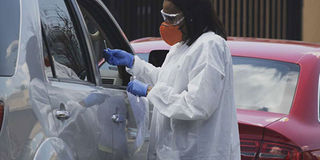Test, test, and test to effectively control Covid-19

A health professional holds a swab test for the Covid-19 at a drive through testing site outside the Lancet Laboratories facilities in Johannesburg, on March 19, 2020. PHOTO | MARCO LONGARI | AFP
What you need to know:
- We can try to test as many people as possible in order to map the pandemic and guide us on where to spend most of our resources.
- A well-designed random survey would achieve results close to those of a mass testing campaign, within a reasonable margin of error.
The first strategy in a pandemic is usually aimed at preventing it from establishing itself within a territory.
Often, we lose sight of this strategy once the infection enters a particular region, and start imagining that other strategies must take precedence at that point.
It is my assertion that as the infection spreads across the world, there are always areas that remain unaffected until the very end when everybody gets it, if it gets there.
The strategy we design must, therefore, aim at protecting people and areas that are free of the infection from getting it, while doing everything possible to limit its spread in the places in which it has established itself.
To do this, we must know where the enemy is in the first place. There are a couple of ways of ‘knowing’ this.
Traditionally, we have depended on the appearance of characteristic symptoms of a disease after which we would aim at isolating all infected and their direct contacts.
Unfortunately this only works for diseases that only spread after people develop signs and symptoms. Covid-19 is not one of those.
USE TECHNOLOGY
The other way of ‘knowing’, which applies to the current pandemic, is to use accurate tests to identify those infected even before they show signs or symptoms of the disease.
Firstly, of course, we must test all those presenting with features of the disease, and for those who test positive, we must trace and test all their contacts.
The main difficulty with this approach is that people have limited memories. Some countries have solved this problem using technology that tracks peoples contacts, and perhaps our tech community should help here given our exemplary mobile telephony penetration.
Unfortunately, not every infected person will show up for the test, and most infected people will in fact not show any manifestations for several days during which they remain infectious.
To mitigate this, we can do one of two things. With sufficient resources, we can try to test as many people as possible in order to map the pandemic and guide us on where to spend most of our resources.
MASS TESTING
This will also help us to isolate people and areas that are affected, and allow unaffected areas to continue operating as close to normally as possible.
In our case, it appears that we do not have sufficient testing kits to test everyone, and due to our scarcity mentality, this is unlikely to change soon enough to be of any benefit.
We, therefore, need another approach that can approximate the mass testing strategy.
What would work best for this is a scientifically designed random testing and surveillance of representative samples in the community, as is routinely done for other conditions.
A well-designed random survey would achieve results close to those of a mass testing campaign, within a reasonable margin of error.
The results would help create a snapshot of a likely person or area at risk, and this would inform more targeted testing and isolation, helping to slow the spread of the infection and rationally deploy our resources to control it.
If we do nothing else, the least we can do is to design a strategy to “know” where the enemy is; to isolate it, and then attack it from a position of strength.
Anything else amounts to shooting in the dark and is a recipe for catastrophe.
Lukoye Atwoli is Associate Professor of Psychiatry at Moi University School of Medicine; [email protected]





